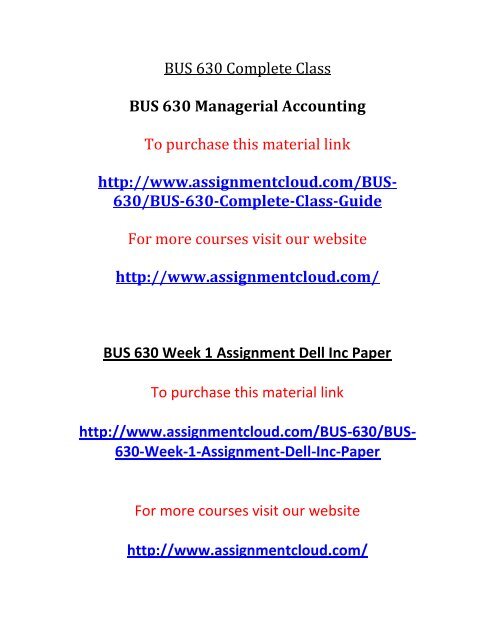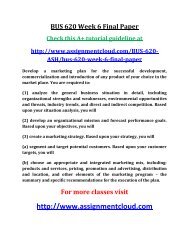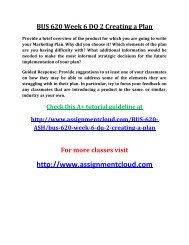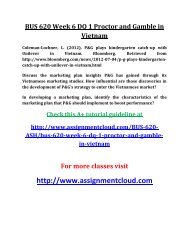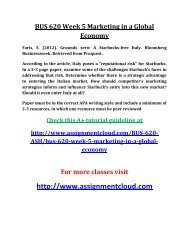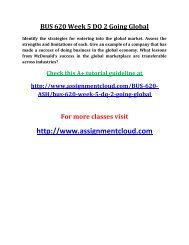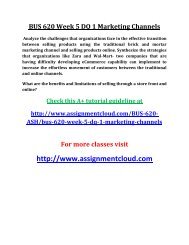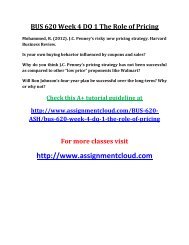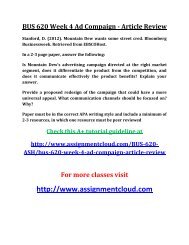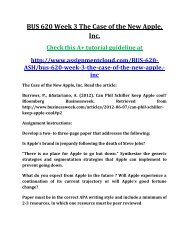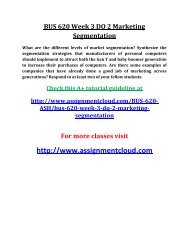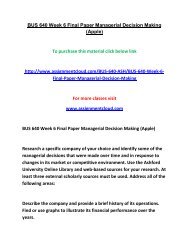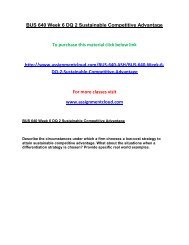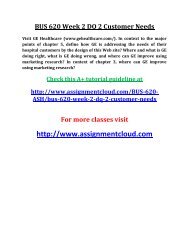BUS 630 Complete Class
You also want an ePaper? Increase the reach of your titles
YUMPU automatically turns print PDFs into web optimized ePapers that Google loves.
<strong>BUS</strong> <strong>630</strong> <strong>Complete</strong> <strong>Class</strong><br />
<strong>BUS</strong> <strong>630</strong> Managerial Accounting<br />
To purchase this material link<br />
http://www.assignmentcloud.com/<strong>BUS</strong>-<br />
<strong>630</strong>/<strong>BUS</strong>-<strong>630</strong>-<strong>Complete</strong>-<strong>Class</strong>-Guide<br />
For more courses visit our website<br />
http://www.assignmentcloud.com/<br />
<strong>BUS</strong> <strong>630</strong> Week 1 Assignment Dell Inc Paper<br />
To purchase this material link<br />
http://www.assignmentcloud.com/<strong>BUS</strong>-<strong>630</strong>/<strong>BUS</strong>-<br />
<strong>630</strong>-Week-1-Assignment-Dell-Inc-Paper<br />
For more courses visit our website<br />
http://www.assignmentcloud.com/
Submit a paper on one of the major topics listed<br />
below using one of the recommended<br />
journal articles found in the syllabus as the basis for<br />
the paper and incorporating at least two other<br />
related articles of the student’s choice:<br />
Outsourcing<br />
Supply Chain Management<br />
Cost Cutting<br />
Budgeting<br />
Options<br />
The paper must (a) identify the main issues in the<br />
chosen area, (b) apply and reference new learning<br />
that has occurred, (c) build upon class activities or<br />
incidents that facilitated learning and<br />
understanding, and (d) present specific current<br />
and/or future applications and relevance to the<br />
workplace. The emphasis of the paper should be on<br />
application of new learning.<br />
use article;<br />
http://www.sec.gov/Archives/edgar/data/826083/<br />
000095013405004423/d22995e10vk.htm<br />
Must be eight- double-spaced pages in length<br />
and formatted according to APA style as<br />
outlined in the approved APA style guide.<br />
Papers with more or less than eight pages in<br />
length will have two points deducted from the
final score for each page over or under,<br />
exclusive of Appendix, References, Exhibits,<br />
etc.<br />
Must include an introductory paragraph with a<br />
succinct thesis statement.<br />
Must address the topic of the paper with<br />
critical thought.<br />
Must conclude with a restatement of the thesis<br />
and a conclusion paragraph.<br />
Must use APA style as outlined in the approved<br />
APA style guide to document all sources.<br />
Must include, on the final page, a Reference List<br />
that is completed according to APA style as<br />
outlined in the approved APA style guide.<br />
<strong>BUS</strong> <strong>630</strong> Week 1 DQ 1 Theory of Constraints<br />
Apply the Theory of Constraints to your own<br />
working environment (past or present). Explain<br />
why your organization doesn’t have unlimited<br />
resources (space, inventory, product line, etc).<br />
Explain why there are always limits to what your<br />
organization can do.<br />
To purchase this material link
http://www.assignmentcloud.com/<strong>BUS</strong>-<br />
<strong>630</strong>/<strong>BUS</strong>-<strong>630</strong>-Week-1-DQ-1-Theory-of-<br />
Constraints<br />
For more courses visit our website<br />
http://www.assignmentcloud.com/<br />
<strong>BUS</strong> <strong>630</strong> Week 1 DQ 2 Kranbrack Corporation<br />
To purchase this material link<br />
http://www.assignmentcloud.com/<strong>BUS</strong>-<strong>630</strong>/<strong>BUS</strong>-<br />
<strong>630</strong>-Week-1-DQ-2-Kranbrack-Corporation<br />
For more courses visit our website<br />
http://www.assignmentcloud.com/<br />
M.K. Gallant is president of Kranbrack Corporation,<br />
a company whose stock is traded on a national<br />
exchange. In a meeting with investment analysts at
the beginning of the year, Gallant had predicted<br />
that the company’s earnings would grow by 20%<br />
this year. Unfortunately, sales have been less than<br />
expected for the year, and Gallant concluded with<br />
two weeks of the end of the fiscal year that it<br />
would impossible to ultimately report an increase<br />
in earning as large as predicted unless some drastic<br />
action was taken. Accordingly, Gallant has ordered<br />
that wherever possible, expenditures should be<br />
postponed to the new year – including canceling or<br />
postponing orders with suppliers, delaying planned<br />
maintenance and training, and cutting back on endof-the-year<br />
advertising and travel. Additionally,<br />
Gallant ordered the company’s controller to<br />
carefully scrutinize all costs that are currently<br />
classified as period costs and reclassify as many as<br />
possible as product costs. The company is expected<br />
to have substantial inventories of work in process<br />
and finished goods at the end of the year.<br />
Comment on the following questions. Respond to<br />
at least two of your fellow students’ postings.<br />
Why would reclassifying period costs as<br />
product costs increase this period’s reported<br />
earnings?<br />
Do you believe Gallant’s actions are ethical?<br />
Why or why not?
Assgnt. The questions in this exercise are based<br />
on Dell, Inc. To answer the questions, you will need<br />
to download Dell’s 2005 Form 10-K. You do not<br />
need to print this document in order to answer the<br />
questions.<br />
What is Dell’s strategy for success in the<br />
marketplace? Does the company rely primarily<br />
on a customer intimacy, operational<br />
excellence, or product leadership customer<br />
value proposition? What evidence supports<br />
your conclusion?<br />
What business risks does Dell face that may<br />
threaten its ability to satisfy stockholder<br />
expectations? What are some examples of<br />
control activities that the company could use to<br />
reduce these risks? (Hint: Focus on pages 7-10<br />
of the 10-K.)<br />
How as the Sarbanes-Oxley Act of 2002<br />
explicitly affected the disclosures contained in<br />
Dell’s 10-K report? (Hint: Focus on pages 34-35,<br />
59, and 76-78.)<br />
Is Dell a merchandiser or a manufacturer?<br />
What information contained in the 10-K<br />
supports your answer?<br />
What are some examples of direct and indirect<br />
inventoriable costs for Dell? Why has Dell’s
gross margin (in dollars) steadily increased<br />
from 2003 to 2005, yet the gross margin as a<br />
percentage of net revenue only increased<br />
slightly?<br />
What is the inventory balance on Dell’s January<br />
28, 2005 balance sheet? Why is the inventory<br />
balance so small compared to the other current<br />
asset balances? What competitive advantage<br />
does Dell derive from its low inventory levels?<br />
Page 27 of Dell’s 10-K reports a figure called<br />
the crash conversion cycle. The cash conversion<br />
cycle for Dell has consistently been negative. Is<br />
this a good sign for Dell or a bad sign? Why?<br />
Describe some of the various types of<br />
operating expenses incurred by Dell. Why are<br />
these expenses treated as period costs?<br />
List four different cost objects for Dell. For each<br />
cost object, mention one example of a direct<br />
cost and an indirect cost.<br />
<strong>BUS</strong> <strong>630</strong> Week 2 Assignment Basic CVP<br />
Analysis Fashion Shoe Company
To purchase this material link<br />
http://www.assignmentcloud.com/<strong>BUS</strong>-<br />
<strong>630</strong>/<strong>BUS</strong>-<strong>630</strong>-Week-2-Assignment-Basic-CVP-<br />
Analysis-Fashion-Shoe-Company<br />
For more courses visit our website<br />
http://www.assignmentcloud.com/<br />
<strong>Complete</strong> the following exercise<br />
(Problem 4-21) and submit to your instructor.<br />
The Fashion Shoe Company operates a chain of<br />
women’s shoe shops around the country. The<br />
shops carry many styles of shoes that are all<br />
sold at the same price. Sales personnel in the<br />
shops are paid a substantial commission on<br />
each pair of shoes sold (in addition to a small<br />
basic salary) in order to encourage them to be<br />
aggressive in their sales efforts.<br />
The following worksheet contains cost and<br />
revenue data for Shop 48 and is typical of the
company’s many outlets:<br />
Per Pair<br />
of<br />
Shoes<br />
Selling<br />
price<br />
$<br />
30.00<br />
Variable<br />
expenses:<br />
Invoice<br />
cost<br />
$<br />
13.50<br />
Sales<br />
commission 4.50<br />
Total<br />
variable<br />
expenses<br />
$<br />
18.00
Annual<br />
Fixed<br />
expenses:<br />
Advertising $<br />
30,000<br />
Rent<br />
20,000<br />
Salaries<br />
Total fixed<br />
expenses<br />
100,000<br />
$<br />
150,000<br />
<br />
<br />
Calculate the annual break-even point in<br />
dollar sales and in unit sales for Shop 48.<br />
Prepare a CVP graph showing cost and<br />
revenue data for Shop 48 from zero shoes<br />
up to 17,000 pairs of shoes sold each year.<br />
Clearly indicate the break-even point on<br />
the graph.
If 12,000 pairs of shoes are sold in a year,<br />
what would be Shop 48's net operating<br />
income or loss?<br />
The company is considering paying the<br />
store manager of Shop 48 an<br />
incentive commission of Shop 48 an<br />
incentive commission of 75 cents per pair<br />
of shoes (in addition to the salesperson's<br />
commission). If this change is made, what<br />
will be the new break-even point in dollar<br />
sales and in unit sales?<br />
Refer to the original data. As an alternative<br />
to (4) above, the company is considering<br />
paying the store manager 50 cents<br />
commission on each pair of shoes sold in<br />
excess of the break-even point. If this<br />
change is made, what will be the shop's net<br />
operating income or loss if 15,000 pairs of<br />
shoes are sold?<br />
Refer to the original data. The company is<br />
considering eliminating sales commissions<br />
entirely in its shops and increasing fixed<br />
salaries by $31,500 annually. If this change<br />
is made, what will be the new break-even<br />
point in dollar sales and in unit sales for<br />
Shop 48? Would you recommend that the<br />
change be made? Explain.
Carefully review the Grading Rubric for the<br />
criteria that will be used to evaluate your<br />
assignment.<br />
<strong>BUS</strong> <strong>630</strong> Week 2 DQ 1 Downsizing and Fixed Cost<br />
To purchase this material link<br />
http://www.assignmentcloud.com/<strong>BUS</strong>-<strong>630</strong>/<strong>BUS</strong>-<br />
<strong>630</strong>-Week-2-DQ-1-Downsizing-and-Fixed-Cost<br />
For more courses visit our website<br />
http://www.assignmentcloud.com/<br />
Downsizing and Fixed Costs<br />
1. Industry downsizing has been a major part of<br />
the corporate world, even government<br />
agencies are downsizing.<br />
GovernmentExecutive.com "covers the
usiness of the federal government and its<br />
huge departments and agencies - dozens of<br />
which dwarf the largest institutions<br />
in the private sector" on its website. Read the<br />
assigned Government Executive<br />
article and answer the following questions:<br />
Which industries have substantially reduced<br />
fixed cost commitments?<br />
Do you believe this reduction in costs has<br />
substantially impaired the ability of these<br />
industries to meet the needs of their<br />
customers? Respond to at least two of your<br />
fellow students’ postings.<br />
<strong>BUS</strong> <strong>630</strong> Week 2 DQ 2 Direct Labor Variable or<br />
Fixed Cost<br />
Throughout the corporate world, businesses are<br />
transforming labor into a more flexible (and<br />
variable) cost. Among such companies are<br />
Hewlett-Packard, General Electric, DuPont, Sun<br />
Microsystems, and British Airways. Discuss<br />
whether direct labor is a fixed or a variable cost.<br />
What are the pros and cons of management
treating direct labor as a variable cost? Are there<br />
ethical issues to be considered here?<br />
To purchase this material link<br />
http://www.assignmentcloud.com/<strong>BUS</strong>-<br />
<strong>630</strong>/<strong>BUS</strong>-<strong>630</strong>-Week-2-DQ-2-Direct-Labor-<br />
Variable-or-Fixed-Cost<br />
For more courses visit our website<br />
http://www.assignmentcloud.com/<br />
<strong>BUS</strong> <strong>630</strong> Week 3 Assignment JetBlue Airways<br />
To purchase this material link<br />
http://www.assignmentcloud.com/<strong>BUS</strong>-<strong>630</strong>/<strong>BUS</strong>-<br />
<strong>630</strong>-Week-3-Assignment-JetBlue-Airways<br />
For more courses visit our website<br />
http://www.assignmentcloud.com/
<strong>Complete</strong> the following exercise (Research and<br />
Application 7-20) and submit to your instructor.<br />
The questions in this exercise are based on JetBlue<br />
Airways Corporation. To answer the questions, you<br />
will need to download JetBlue’s 10-K/A for the year<br />
ended December 31, 2004 (10K/A with a filing date<br />
of March 8, 2005). You do not need to print the 10-<br />
K/A to answer the questions.<br />
Required:<br />
• What is JetBlue’s strategy for success in the<br />
marketplace? Does the company rely primarily on<br />
a customer intimacy, operational excellence, or<br />
product leadership customer value proposition?<br />
What evidence supports your conclusion?<br />
• What business risks does JetBlue face that may<br />
threaten the company’s ability to satisfy<br />
stockholder expectations? What are some<br />
examples of control activities that the company<br />
could use to reduce these risks? (Hint: Focus on<br />
pages 17-23 of the 10-K/A.)<br />
• How can the concept of unit-level activities be<br />
applies to an airline? More specifically, what are<br />
two examples of unit-level activities for JetBlue?<br />
What steps has JetBlue taken to manage these<br />
unit-level activities more efficiently?
• How can the concept of batch-level activities be<br />
applied to an airline? What are two examples of<br />
batch-level activities for JetBlue? What steps has<br />
JetBlue taken to manage these batch-level activities<br />
more efficiently?<br />
• What is one example of a customer-level<br />
activity and an organization-sustaining activity for<br />
JetBlue?<br />
Noreen, E. W., Brewer, P. B., Garrison R. H. (2011).<br />
Managerial accounting for managers (2nd ed.).<br />
New York, NY: McGraw Hill. ISBN: 978-0-07-<br />
352713-0.<br />
<strong>BUS</strong> <strong>630</strong> Week 3 DQ 1 Fixed Labor<br />
To purchase this material link<br />
http://www.assignmentcloud.com/<strong>BUS</strong>-<strong>630</strong>/<strong>BUS</strong>-<br />
<strong>630</strong>-Week-3-Assignment-JetBlue-Airways
For more courses visit our website<br />
http://www.assignmentcloud.com/<br />
Far North Telecom, Ltd., of Ontario, has organized a<br />
new division to manufacture and sell specialty<br />
cellular telephones. The division’s monthly costs<br />
are shown in the table below. Far North Telecom<br />
regards all of its workers as full-time employees<br />
and the company has a long-standing no layoff<br />
policy. Furthermore, production is highly<br />
automated. Accordingly, the company includes its<br />
labor costs in its fixed manufacturing overhead.<br />
The cellular phones sell for $150 each. During<br />
September, the first month of operations, the<br />
following activity was recorded: 12,000 units<br />
produced, 10,000 units sold. Comment on the five<br />
questions below the table. Respond to at least two<br />
of your fellow students’ postings.<br />
Manufacturing costs:<br />
Variable costs per<br />
unit:<br />
Direct Materials $48<br />
Variable<br />
$2<br />
manufacturing
overhead<br />
Fixed manufacturing<br />
overhead costs (total) $360,000<br />
Selling and<br />
administration costs:<br />
Variable<br />
12% of<br />
sales<br />
Fixed (total) $470,000<br />
a. Compute the unit product cost under:<br />
i. absorption costing<br />
ii. variable costing<br />
b. Prepare an absorption costing income statement<br />
for September<br />
c. Prepare a contribution format income statement<br />
for September using variable costing.<br />
d. Assume that the company must obtain<br />
additional financing in order to continue<br />
operations. As a member of top management,<br />
would you prefer to rely n the statement in (b)<br />
above or in (3) above when meeting with a group of<br />
prospective investors?<br />
e. Reconcile the absorption costing and variable<br />
costing net operating incomes in (2) and (3) above.
<strong>Complete</strong> the following exercise (Research and<br />
Application 7-20) and submit to your instructor.<br />
The questions in this exercise are based on JetBlue<br />
Airways Corporation. To answer the questions, you<br />
will need to download JetBlue’s 10-K/A for the year<br />
ended December 31, 2004 (10K/A with a filing date<br />
of March 8, 2005). You do not need to print the 10-<br />
K/A to answer the questions.<br />
Required:<br />
• What is JetBlue’s strategy for success in the<br />
marketplace? Does the company rely primarily on<br />
a customer intimacy, operational excellence, or<br />
product leadership customer value proposition?<br />
What evidence supports your conclusion?<br />
• What business risks does JetBlue face that may<br />
threaten the company’s ability to satisfy<br />
stockholder expectations? What are some<br />
examples of control activities that the company<br />
could use to reduce these risks? (Hint: Focus on<br />
pages 17-23 of the 10-K/A.)<br />
• How can the concept of unit-level activities be<br />
applies to an airline? More specifically, what are<br />
two examples of unit-level activities for JetBlue?<br />
What steps has JetBlue taken to manage these<br />
unit-level activities more efficiently?
• How can the concept of batch-level activities be<br />
applied to an airline? What are two examples of<br />
batch-level activities for JetBlue? What steps has<br />
JetBlue taken to manage these batch-level activities<br />
more efficiently?<br />
• What is one example of a customer-level<br />
activity and an organization-sustaining activity for<br />
JetBlue?<br />
Noreen, E. W., Brewer, P. B., Garrison R. H. (2011).<br />
Managerial accounting for managers (2nd ed.).<br />
New York, NY: McGraw Hill. ISBN: 978-0-07-<br />
352713-0.<br />
<strong>BUS</strong> <strong>630</strong> Week 3 DQ 2 Profitability<br />
To purchase this material link<br />
http://www.assignmentcloud.com/<strong>BUS</strong>-<br />
<strong>630</strong>/<strong>BUS</strong>-<strong>630</strong>-Week-3-DQ-2-Profitability<br />
For more courses visit our website
http://www.assignmentcloud.com/<br />
<strong>Complete</strong> the following exercise and respond to at<br />
least two of your fellow students' postings.<br />
Gallatin Carpet Cleaning is a small, family-owned<br />
business operating out of Bozeman, Montana. For<br />
its services, the company has always charged a flat<br />
fee per hundred square feet of carpet cleaned. The<br />
current fee is $28 per hundred square feet.<br />
However, there is some question about whether<br />
the company is actually making any money on<br />
jobs for some customers-particularly those located<br />
on remote ranches that require considerable<br />
travel time. The owner's daughter, home for the<br />
summer from college, has suggested investigating<br />
this question using activity-based costing. After<br />
some discussion, a simple system consisting of four<br />
activity cost pools seemed to be adequate. The<br />
activity cost pools and their activity measures<br />
appear below:<br />
Activity Cost Pool<br />
Cleaning carpets<br />
Activity<br />
Measure<br />
Square<br />
feet<br />
cleaned<br />
Activity<br />
for the<br />
Year<br />
20,000<br />
hundred
Travel to jobs<br />
Job support<br />
Other (costs of idle<br />
capacity and<br />
organization-sustaining<br />
costs)<br />
(00s)<br />
square<br />
feet<br />
Miles 60,000<br />
driven miles<br />
Number of<br />
2,000 jobs<br />
jobs<br />
None<br />
Not<br />
applicable<br />
The total cost of operating the company for the<br />
year is $430,000, which includes the following<br />
costs:<br />
Wages<br />
$<br />
150,000<br />
Cleaning<br />
supplies 40,000<br />
Cleaning<br />
equipment<br />
20,000<br />
depreciation<br />
Vehicle<br />
expenses 80,000<br />
Office expenses 60,000
President's<br />
compensation 80,000<br />
$<br />
430,000<br />
Resource consumption is distributed across the<br />
activities as follows:<br />
Distribution<br />
of Resource<br />
Consumptio<br />
n Across<br />
Activities<br />
Cleanin<br />
g<br />
Trave<br />
l to<br />
Job<br />
Carpets Jobs Suppor<br />
t<br />
Othe<br />
r<br />
Total<br />
100<br />
Wages 70% 20% 0% 10%<br />
%<br />
Cleaning<br />
100<br />
100% 0% 0% 0%<br />
supplies<br />
%<br />
Cleaning<br />
100<br />
equipment 80% 0% 0% 20%<br />
%<br />
depreciation<br />
Vehicle<br />
100<br />
0% 60% 0% 40%<br />
expenses<br />
%<br />
Office 0% 0% 45% 55% 100
expenses %<br />
President's<br />
100<br />
compensatio 0% 0% 40% 60%<br />
%<br />
n<br />
Job support consists of receiving calls from<br />
potential customers at the home office, scheduling<br />
jobs, billing, resolving issues, and so on.<br />
Using Exhibit 7-5 as a guide, prepare the firststage<br />
allocation of costs to the activity cost<br />
pools.<br />
Using Exhibit 7-6 as a guide, compute the<br />
activity rates for the activity cost pools.<br />
The company recently completed a 5 hundred<br />
square foot carpet -cleaning job at the Flying<br />
N ranch--a 75-mile round-trip journey from<br />
the company's offices in Bozeman. Compute<br />
the cost of this job using the activity-based<br />
costing system.<br />
The revenue from the Flying N ranch was<br />
$140 (5 hundred square feet @ $28 per<br />
hundred square feet). Using Exhibit 7-11 as a<br />
guide, prepare a report showing the margin<br />
from this job.<br />
What do you conclude concerning the<br />
profitability of the Flying N ranch job?<br />
Explain.
What advice would you give the president<br />
concerning pricing jobs in the future?<br />
<strong>BUS</strong> <strong>630</strong> Week 4 Assignment Master Budget Exercise<br />
To purchase this material link<br />
http://www.assignmentcloud.com/<strong>BUS</strong>-<strong>630</strong>/<strong>BUS</strong>-<br />
<strong>630</strong>-Week-4-Assignment-Master-Budget-Exercise<br />
For more courses visit our website<br />
http://www.assignmentcloud.com/<br />
<strong>Complete</strong> the following three exercises and submit<br />
to your instructor. Be sure to show your work for<br />
calculations to earn full credit.<br />
Sales and Production Budgets (8-12): The marketing<br />
department of Jessi Corporation has submitted the
following sales forecast for the upcoming fiscal year<br />
(all sales are on account):<br />
1 st Quarte 2 nd Quarte 3 rd Quarte 4 th Quarte<br />
r r r r<br />
Units to<br />
be<br />
produce<br />
d<br />
11,000 12,000 14,000 13,000<br />
The selling price of the company's product is $18.00<br />
per unit. Management expects to collect 65% of<br />
sales in the quarter in which the sales are made,<br />
30% in the following quarter, and 5% of sales are<br />
expected to be "'uncollectible. The beginning<br />
balance of accounts receivable, all of which is<br />
expected to be collected in the first quarter, is<br />
$70,200. The company expects to start the first<br />
quarter with 1,650 units in finished goods<br />
inventory. Management desires an ending finished<br />
goods inventory in each quarter equal to 15% of the<br />
next quarter's budgeted sales. The desired ending<br />
finished goods inventory for the fourth quarter is<br />
1,850 units.<br />
· Prepare the company's sales budget<br />
and schedule of expected cash collections.
· Prepare the company's production<br />
budget for the upcoming fiscal year.<br />
Direct Materials and Direct Labor Budgets (8-<br />
13): The production department of Hareston<br />
Company has submitted the following forecast of<br />
units to be produced by quarter for the upcoming<br />
fiscal year:<br />
1 st Quarte<br />
r<br />
Units to<br />
be<br />
produce<br />
d<br />
2 nd Quarte<br />
r<br />
3 rd Quarte<br />
r<br />
4 th Quarte<br />
r<br />
7,000 8,000 6,000 5,000<br />
In addition, the beginning raw materials inventory<br />
for the first quarter is budgeted to be 1,400 pounds<br />
and the beginning accounts payable for the first<br />
quarter is budgeted to be $2,940. Each unit requires<br />
2 pounds of raw material that costs $1.40 per<br />
pound. Management desires to end each quarter<br />
with an inventory of raw materials equal to 10% of<br />
the following quarter's production needs. The<br />
desired ending inventory for the fourth quarter is<br />
1,500 pounds. Management plans to pay for 80% of<br />
raw material purchases in the quarter acquired and<br />
20% in the following quarter. Each unit requires
0.60 direct labor-hours and direct labor-hour<br />
workers are paid $14.00 per hour.<br />
· Prepare the company's direct materials budget<br />
and schedule of expected cash disbursements for<br />
purchases of materials for the upcoming fiscal year.<br />
· Prepare the company's direct labor budget for the<br />
upcoming fiscal year, assuming that the direct labor<br />
workforce is adjusted each quarter to match the<br />
number of hours required to produce the<br />
forecasted number of units produced.<br />
Direct Labor and Manufacturing Overhead Budgets<br />
(8-14): The production department of Raredon<br />
Corporation has submitted the following forecast of<br />
units to be produced by quarter for the upcoming<br />
fiscal year:<br />
1 st Quarte<br />
r<br />
Units to<br />
be<br />
produce<br />
d<br />
2 nd Quarte<br />
r<br />
3 rd Quarte<br />
r<br />
4 th Quarte<br />
r<br />
12,000 14,000 13,000 11,000<br />
Each unit requires 0.70 direct labor-hours, and<br />
direct labor-hour workers are paid $10.50 per hour.<br />
In addition, the variable manufacturing overhead<br />
rate is $1.50 per direct labor-hour. The fixed
manufacturing overhead is $80,000 per quarter.<br />
The only noncash element of manufacturing<br />
overhead is depreciation, which is $22,000 per<br />
quarter.<br />
· Prepare the company's direct labor budget for the<br />
upcoming fiscal year, assuming that the direct labor<br />
workforce is adjusted each quarter to match the<br />
number of hours required to produce the<br />
forecasted number of units produced.<br />
· Prepare the company's manufacturing overhead<br />
budget.<br />
Carefully review the Grading Rubric for the criteria<br />
that will be used to evaluate your assignment.<br />
<strong>BUS</strong> <strong>630</strong> Week 4 DQ 1 Behavioral Aspects of<br />
Budgeting<br />
To purchase this material link<br />
http://www.assignmentcloud.com/<strong>BUS</strong>-<br />
<strong>630</strong>/<strong>BUS</strong>-<strong>630</strong>-Week-4-DQ-1-Behavioral-<br />
Aspects-of-Budgeting
For more courses visit our website<br />
http://www.assignmentcloud.com/<br />
Norton Company, a manufacturer of infant<br />
furniture and carriages, is in the initial stages<br />
of preparing the annual budget for next year.<br />
Scott Ford has recently joined Norton’s<br />
accounting staff and is interested to learn as<br />
much as possible about the company’s<br />
budgeting process. During a recent lunch with<br />
Marge Atkins, sales manager, and Pete<br />
Granger, production manager. Ford initiated<br />
the conversation below. Read the conversation<br />
and answer the questions that follow.<br />
Respond to at least two of your fellow<br />
students’ postings.<br />
Ford:<br />
Since I’m new around here and am going to be<br />
involved with the preparation of the annual<br />
budget, I’d be interested to learn how the two<br />
of you estimate sales and production numbers.<br />
Atkins:
We start out very methodically by looking at<br />
recent history, discussing what we know about<br />
current accounts, potential customers, and the<br />
general state of consumer spending. Then, we<br />
add that usual dose of intuition to come up<br />
with the best forecast we can.<br />
Granger:<br />
I usually take the sales projections as the basis<br />
for my projections. Of course, we have to make<br />
an estimate of what this year’s ending<br />
inventories will be, which is sometimes<br />
difficult.<br />
Ford:<br />
Why does that present a problem? There must<br />
have been an estimate of ending inventories in<br />
the budget for the current year.<br />
Granger:<br />
Those numbers aren’t always reliable because<br />
Marge makes some adjustments to the sales<br />
numbers before passing them on to me.<br />
Ford:<br />
What kind of adjustments?<br />
Atkins:
Well, we don’t want to fall short of the sales<br />
projections so we generally give ourselves a<br />
little breathing room by lowering the initial<br />
sales projection anywhere from 5% to 10%.<br />
Granger:<br />
So, you can see why this year’s budget is not a<br />
very reliable starting point. We always have to<br />
adjust the projected production rates as the<br />
year progresses and, of course, this changes<br />
the ending inventory estimates. By the way,<br />
we make similar adjustments to expenses by<br />
adding at least 10% to the estimates; I think<br />
everyone around here does the same thing.<br />
a. Marge Atkins and Pete Granger have<br />
described the use of what is sometimes called<br />
budgetary slack.<br />
i. Explain why Atkins and Granger behave in<br />
this manner and describe the benefits they<br />
expect to realize from the use of budgetary<br />
slack.<br />
ii. Explain how the use of budgetary slack<br />
can adversely affect Atkins and Granger.<br />
b. As a management accountant, Scott Ford<br />
believes that the behavior described by Marge<br />
Atkins and Pete Granger may be unethical. By<br />
referring to the IMA’s Statement of Ethical
Professional Practice in chapter 1, explain why<br />
the use of budgetary slack may be unethical.<br />
<strong>BUS</strong> <strong>630</strong> Week 4 DQ 2 Critiquing a Cost Report<br />
To purchase this material link<br />
http://www.assignmentcloud.com/<strong>BUS</strong>-<strong>630</strong>/<strong>BUS</strong>-<br />
<strong>630</strong>-Week-4-DQ-2-Critiquing-a-Cost-Report<br />
For more courses visit our website<br />
http://www.assignmentcloud.com/<br />
<strong>Complete</strong> the following exercise: Frank Weston,<br />
supervisor of the Freemont Corporation's<br />
Machining Department, was visibly upset after<br />
being reprimanded for his department's poor<br />
performance over the prior month. The<br />
department's cost control report is given below:
"I just can't understand all the red ink," Weston<br />
complained to the supervisor of another<br />
department. "When the boss called me in, I<br />
thought he was going to give me a pat on the back<br />
because I know for a fact that my department<br />
worked more efficiently last month than it has ever<br />
worked before, instead, he tore me apart. I thought<br />
for a minute that it might be over the supplies that<br />
were stolen out of our warehouse last month. But<br />
they only amounted to a couple of hundred dollars,<br />
and just look at this report. Everything is<br />
unfavorable." Direct labor wages and supplies are<br />
variable costs; supervision and depreciation are<br />
fixed costs; and maintenance and utilities are<br />
mixed costs. The fixed component of the budgeted<br />
maintenance cost is $92,000; the fixed component<br />
of the budgeted utilities cost is $11,700.<br />
Freemont<br />
Corporation-<br />
Machining<br />
Department<br />
Cost Control Report<br />
For the Month Ended<br />
June 30<br />
Planning<br />
Budget<br />
Actual<br />
Results Variances
Machine-hours 35,000 38,000<br />
Direct labor wages $80,500 $86,100 $5,600 U<br />
Supplies 21,000 23,100 2,100 U<br />
Maintenance 134,000 137,300 3,300 U<br />
Utilities 15,200 15,700 500 U<br />
Supervision 38,000 38,000<br />
Depreciation 80,000 80,000<br />
Total $368,700 $380,200<br />
<br />
<br />
Evaluate the company's cost control report and<br />
explain why the variances were all<br />
unfavorable.<br />
Prepare a performance report that will help<br />
Mr. Weston's superiors assess how well costs<br />
were controlled in the Machining Department.<br />
Respond to at least two of your fellow students’<br />
postings.<br />
<strong>BUS</strong> <strong>630</strong> Week 5 Assignment FedEx<br />
Corporation<br />
To purchase this material link
http://www.assignmentcloud.com/<strong>BUS</strong>-<br />
<strong>630</strong>/<strong>BUS</strong>-<strong>630</strong>-Week-5-Assignment-FedEx-<br />
Corporation<br />
For more courses visit our website<br />
http://www.assignmentcloud.com/<br />
What is FedEx’sstrategy for success in the<br />
marketplace? Does the company rely primarily<br />
on acustomer intimacy, operations excellence,<br />
or product leadership customer<br />
valueproposition? What evidence supports<br />
your conclusion?<br />
What are FedEx’sfour main business<br />
segments? Provide two examples of traceable<br />
fixed costs foreach of FedEx’s four business<br />
segments. Provide two examples of common<br />
costs that are not traceable to the<br />
four business segments.<br />
Identify oneexample of a cost center, a profit<br />
center, and an investment center for FedEx.<br />
Provide threeexamples of fixed costs that can<br />
be traceable or common depending on how
FedExdefines its business segments.<br />
Compute themargin, turnover, and return on<br />
investment (ROI) in 2005 for each of<br />
FedEx’sfour business segments (Hint: page 99<br />
reports total segment assets for eachbusiness<br />
segment.)<br />
Assume that FedExestablished a minimum<br />
required rate of return of 15% for each of its<br />
businesssegments. Compute the residual<br />
income earned in 2005 in each of FedEx’s<br />
foursegments.<br />
Assume that thesenior managers of FedEx<br />
Express and FedEx Ground each have an<br />
investmentopportunity that would require $20<br />
million of additional operating assets andthat<br />
would increase operating income by $4<br />
million. If FedEx evaluates all of its senior<br />
managersusing ROI, would the managers of<br />
both segments pursue the<br />
investment opportunity? If FedEx evaluates all<br />
ofits senior managers using residual income,<br />
would the managers of both segmentspursue<br />
the investment opportunity?
<strong>BUS</strong> <strong>630</strong> Week 5 DQ 1 Variance Analysis in a<br />
Hospital<br />
To purchase this material link<br />
http://www.assignmentcloud.com/<strong>BUS</strong>-<strong>630</strong>/<strong>BUS</strong>-<br />
<strong>630</strong>-Week-5-DQ-1-Variance-Analysis-in-a-Hospital<br />
For more courses visit our website<br />
http://www.assignmentcloud.com/<br />
<strong>Complete</strong> problem 10-15 in the text and answer the<br />
three required questions. John Fleming, chief<br />
administrator for Valley View Hospital, is concerned<br />
about the costs for tests in the hospital's lab.<br />
Charges for lab tests are consistently higher at<br />
Valley View than at other hospitals and have<br />
resulted in many complaints. Also, because of strict<br />
regulations on amounts reimbursed for lab tests,<br />
payments received from insurance companies and<br />
governmental units have not been high enough to<br />
cover lab costs. Mr. Fleming has asked you to
evaluate costs in the hospital's lab for the past<br />
month. The following information is available:<br />
Two types of tests are performed in the labblood<br />
tests and smears. During the past month,<br />
1,800 blood tests and 2,400 smears were<br />
performed in the lab. Small glass plates are<br />
used in both types of tests. During the past<br />
month, the hospital purchased 12,000 plates at<br />
a cost of $28,200. This cost is net of a 6%<br />
quantity discount. 1,500 of these plates were<br />
unused at the end of the month; no plates<br />
were on hand at the beginning of the month.<br />
During the past month, 1,150 hours of labor<br />
time were recorded in the lab at a cost of<br />
$13,800.<br />
The lab's variable overhead cost last month<br />
totaled $7,820.<br />
Valley View Hospital has never used standard costs.<br />
By searching industry literature, however, you have<br />
determined the following nationwide averages for<br />
hospital labs:<br />
Plates: Two plates are required per lab test. These<br />
plates cost $2.50 each and are disposed of after the<br />
test is completed.<br />
Labor: Each blood test should require 0.3 hours to<br />
complete, and each smear should require 0.15
hours to complete. The average cost of this lab time<br />
is $14 per hour.<br />
Overhead: Overhead cost is based on direct laborhours.<br />
The average rate for variable overhead is $6<br />
per hour.<br />
Compute a materials price variance for the<br />
plates purchased last month and a materials<br />
quantity variance for the plates used last<br />
month.<br />
For labor cost in the lab:<br />
o Compute a labor rate variance and a labor<br />
o<br />
efficiency variance.<br />
In most hospitals, one-half of the workers<br />
in the lab are senior technicians and onehalf<br />
are assistants. In an effort to reduce<br />
costs, Valley View Hospital employs only<br />
one-fourth senior technicians and threefourths<br />
assistants. Would you recommend<br />
that this policy be continued? Explain.<br />
Compute the variable overhead rate and efficiency<br />
variances. Is there any relation between the<br />
variable overhead efficiency variance and the labor<br />
efficiency variance? Explain.
<strong>BUS</strong> <strong>630</strong> Week 5 DQ 2 Perverse Affects of Some<br />
Performance Measures<br />
To purchase this material link<br />
http://www.assignmentcloud.com/<strong>BUS</strong>-<strong>630</strong>/<strong>BUS</strong>-<br />
<strong>630</strong>-Week-5-DQ-2-Perverse-Affects-of-Some-<br />
Performance-Measures<br />
For more courses visit our website<br />
http://www.assignmentcloud.com/<br />
<strong>Complete</strong> the following exercise and provide a<br />
recommendation for each of the four scenarios<br />
presented. There is often more than one way to<br />
improve a performance measure. Unfortunately,<br />
some of the actions taken by managers to make<br />
their performance look better may actually harm<br />
the organization. For example, suppose the<br />
marketing department is held responsible only for<br />
increasing the performance measure "total<br />
revenues," Increases in total revenues may be<br />
achieved by working harder and smarter, but they<br />
can also usually be achieved by simply cutting
prices. The increase in volume from cutting prices<br />
almost always results in greater total revenues;<br />
however, it does not always lead to greater total<br />
profits. Those who design performance<br />
measurement systems need to keep in mind that<br />
managers who are under pressure to perform may<br />
take actions to improve performance measures<br />
that have negative consequences elsewhere. For<br />
each of the following situations, describe actions<br />
that managers might take to show improvement in<br />
the performance measure but which do not actually<br />
lead to improvement in the organization's overall<br />
performance.<br />
Concerned with the slow rate at which new<br />
products are brought to market, top<br />
management of a consumer electronics<br />
company introduces a new performance<br />
measure--speed-to-market. The research and<br />
development department is given<br />
responsibility for this performance measure,<br />
which measures the average amount of time a<br />
product is in development before it is released<br />
to the market for sale.<br />
The CEO of a telephone company has been<br />
under public pressure from city officials to fix<br />
the large number of public pay phones that do
not work. The company's repair people<br />
complain that the problem is vandalism and<br />
damage caused by theft of coins from coin<br />
boxes--particularly in high-crime areas in the<br />
city. The CEO says she wants the problem<br />
solved and has pledged to city officials that<br />
there will be substantial improvement by the<br />
end of the year. To ensure that this is done, she<br />
makes the managers in charge of installing and<br />
maintaining pay phones responsible for<br />
increasing the percentage of public pay phones<br />
that are fully functional.<br />
A manufacturing company has been plagued by<br />
the chronic failure to ship orders to customers<br />
by the promised date. To solve this problem,<br />
the production manager has been given the<br />
responsibility of increasing the percentage of<br />
orders shipped on time. When a customer calls<br />
in an order, the production manager and the<br />
customer agree to a delivery date. If the order<br />
is not completed by that date, it is counted as a<br />
late shipment.<br />
Concerned with the productivity of employees,<br />
the board of directors of a large multinational<br />
corporation has dictated that the manager of<br />
each subsidiary will be held responsible for
increasing the revenue per employee of his or<br />
her subsidiary.<br />
Respond to at least two of your fellow students’<br />
postings.<br />
<strong>BUS</strong> <strong>630</strong> Week 6 Assignment Final Project<br />
Submit a paper on one of the major topics listed<br />
below using one of the recommended<br />
journal articles found in the syllabus as the basis<br />
for the paper and incorporating at least two other<br />
related articles of the student’s choice:<br />
Cost Management<br />
Outsourcing<br />
Supply Chain Management<br />
Cost Cutting<br />
Budgeting<br />
Options<br />
To purchase this material link<br />
http://www.assignmentcloud.com/<strong>BUS</strong>-<br />
<strong>630</strong>/<strong>BUS</strong>-<strong>630</strong>-Week-6-Assignment-Final-<br />
Project<br />
For more courses visit our website<br />
http://www.assignmentcloud.com/
<strong>BUS</strong> <strong>630</strong> Week 6 DQ 1 Make Or Buy<br />
To purchase this material link<br />
http://www.assignmentcloud.com/<strong>BUS</strong>-<br />
<strong>630</strong>/<strong>BUS</strong>-<strong>630</strong>-Week-6-DQ-1-Make-Or-Buy<br />
For more courses visit our website<br />
http://www.assignmentcloud.com/<br />
Han Products manufactures 30,000 units of<br />
part S-6 each year for use on its production<br />
line. At this level of activity, the cost per unit<br />
for part S-6 is as follows:<br />
Direct<br />
$ 3.60<br />
materials<br />
Direct labor 10.00<br />
Variable<br />
manufacturing 2.40<br />
overhead<br />
Fixed<br />
manufacturing 9.00<br />
overhead<br />
Total cost per<br />
$25.00<br />
part
An outside supplier has offered to sell 30,000<br />
units of part S-6 each year to Han Products for<br />
$21 per part. If Han Products accepts this<br />
offer, the facilities now being used to<br />
manufacture part S-6 could be rented to<br />
another company at an annual rental of<br />
$80,000. However, Han Products has<br />
determined that two-thirds of the fixed<br />
manufacturing overhead being applied to part<br />
S-6 would continue even if part S-6 were<br />
purchased from the outside supplier. Prepare<br />
computations showing how much profits will<br />
increase or decrease if the outside supplier’s<br />
offer is accepted. Respond to at least two of<br />
your fellow students’ postings.<br />
<strong>BUS</strong> <strong>630</strong> Week 6 DQ 2 Net Present Value<br />
Analysis<br />
To purchase this material link<br />
http://www.assignmentcloud.com/<strong>BUS</strong>-<br />
<strong>630</strong>/<strong>BUS</strong>-<strong>630</strong>-Week-6-DQ-2-Net-Present-<br />
Value-Analysis
For more courses visit our website<br />
http://www.assignmentcloud.com/<br />
<strong>Complete</strong> the following exercise, using this<br />
Excel template, and respond to at least two of<br />
your fellow students’ postings.. In eight years,<br />
Kent Duncan will retire. He is exploring the<br />
possibility of opening a self-service car wash.<br />
The car wash could be managed in the free<br />
time he has available from his regular<br />
occupation, and it could be closed easily when<br />
he retires. After careful study, Mr. Duncan has<br />
determined the following:<br />
A building in which a car wash could be<br />
installed is available under an eight-year<br />
<br />
lease at a cost of $1,700 per month.<br />
Purchase and installation costs of<br />
equipment would total $200,000. In eight<br />
years the equipment could be sold for<br />
about 10% of its original cost.<br />
An investment of an additional $2,000<br />
would be required to cover working<br />
capital needs for cleaning supplies, change<br />
funds, and so forth. After. eight years, this
working capital would be released for<br />
investment elsewhere.<br />
Both a wash and a vacuum service would<br />
be offered with a wash costing $2.00 and<br />
the vacuum costing $1.00 per use.<br />
The only variable costs associated with the<br />
operation would be 20 cents per wash for<br />
water and 10 cents per use of the vacuum<br />
for electricity.<br />
In addition to rent, monthly costs of<br />
operation would be: cleaning, $450;<br />
insurance, $75; and maintenance, $500.<br />
Gross receipts from the wash would be<br />
about $1,350 per week. According to the<br />
experience of other car washes, 60% of the<br />
customers using the wash would also use<br />
the vacuum.<br />
Mr. Duncan will not open the car wash unless it<br />
provides at least a 10% return.<br />
Assuming that the car wash will be open<br />
52 weeks a year, compute the expected<br />
annual net cash receipts (gross cash<br />
receipts less cash disbursements) from its<br />
operation. (Do not include the cost of the<br />
equipment, the working capital, or the<br />
salvage value in these computations.)<br />
(Ignore income taxes.)
Would you advise Mr. Duncan to open the<br />
car wash? Show computations using the<br />
net present value method of investment<br />
analysis. Round all dollar figures to the<br />
nearest whole dollar. (Ignore income<br />
taxes.)


